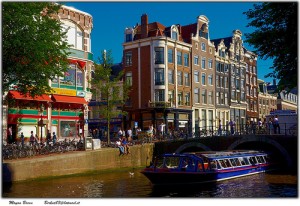
While there are many different kinds of cyclists, there are basically 2 kinds of cycling.
You can participate in organized events, races, and tours, or you can use your bike as a primary form of transportation. For people who fall into this second category, things can get kind of hairy when a city fails to commit to pedal powered commuters. You are the lightest, least protected, most vulnerable vehicle on the road. Cities and governments are beginning to cater more to cyclists, but most have a long way to go before cyclists truly feel safer on their streets.
It is reassuring to note that Salt Lake is quickly climbing the charts of nationally recognized “bike cities.” Recent polls have them in the 40’s and improving. However, of the top 50 bike friendly cities in the nation, (Portland being #1) none of them are on the top 15 bike cities in the world. So what makes a cycling friendly city? What are European Cities doing that America is not? While America makes some delayed strides, lets look at what makes a city great for bikers.
Infrastructure
Copenhagen, Denmark is widely recognized as one of the top 2 or 3 best cities for biking in the world. Much of this recognition comes from the resources they dedicate to cyclists. In a city where one third of all residents use their bikes for getting to work or school, Copenhagen is doing more than just adding bike lanes alongside roads. Recently 1 million dollars has been set aside for a project they are calling “the cycling superhighway” which is a system of 26 bike routes that will connect the suburb areas to central Copenhagen. These are roads built solely and specifically for bikes. Smaller features, such as green wave technology (a biker maintaining a decent speed will go all the way into the city without hitting any red lights,) are completing the city’s stellar bike image.
Commitment
As the old saying goes, if nothing changes, nothing is going to change. Some cities and residents might scoff at the idea of spending 6-7 figures of tax payer dollars on roads or parks designed specifically for cyclists. While the initial cost is high, most studies are showing the huge benefits, including economical ones, that come from having a bike friendly city. Cities in Spain, France, and other European countries are investing substantial funds into bike infrastructure and are seeing early returns. Bikers are much less of a strain on a cities resources and help clear up traffic. Bikers are often healthier and cities that have a high biking population have showed reduced overall health care costs. An unexpected but consistent benefit has been an influx of younger, creative people who seem to flock to these cycle-centric cites. The commitment factor is all about seeing past the misconception that bike focused changes are targeting a small group of avid bikers. As you make biking more accessible, more people feel inclined to do it. Almost 50% of urban trips are less than 2 miles, and 90% of them are done by car. If even half of these trips were bikes, imagine the congestion and pollution we could erase.
Culture
Ironically both the most important and hardest to change, a healthy bike culture is what contributes to the best bike cities on earth. The city that has claimed the crown of best city to bike in the world every year for almost 20 years doesn’t do so because it has the best infrastructure or finances. Amsterdam relentlessly defends that title because of it’s unwavering culture of cycling. In a city of 750,000 people, there are 600,000 registered bicycles. With almost as many bikes as people, they have dethroned the world wide champion cars. A very compact city, they have embraced the cycle as no other place has, partly because widening of the streets is almost impossible. Their winding 17th century roads are perfectly suited for cycles and make driving difficult. When the car started to become popular, Amsterdam could not accommodate every citizen having a car. They quickly legislated laws that encouraged cycling and opened the city up for bikes.
Because America is a relatively young country, we have spent most of our existence with the car. Our cities were built with motorized transport as the mainstay. It is now that we see the congestion and pollution they cause that we are trying to resurrect the bike as a main form of transport. We obviously need to look to our European cousins for examples on how to best improve the lives and safety of two wheeled travelers.
For more information about cycling, specifically the laws in Utah, please call us at 801-LAW-BOOKS for a free copy of a book all about it.
Image courtesy of Moyan Brenn
